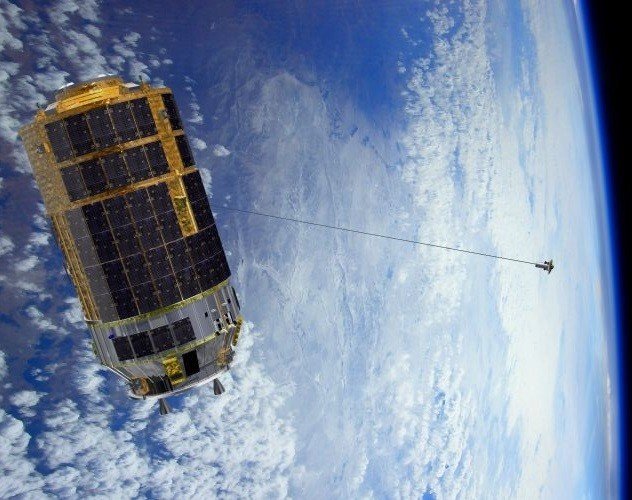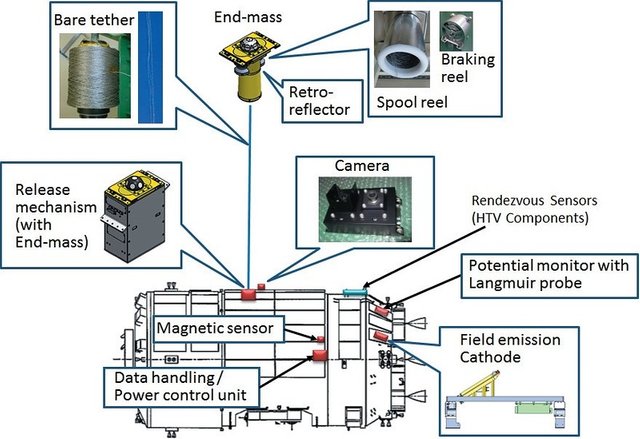Cleaning Earth orbit of space debris with tether
On Jan 27, Japanese automatic cargo vessel HTV undocked from ISS. Instead of immediate braking, to enter atmosphere and burn, it came to lower orbit: 360 x 370 kilometers, so it couldn't crush into ISS. Engineers planned very interesting experiment, Proof of Concept for future space debris cleaner. It was expected that during the next week, space truck will deploy 700 meters tether and check the concept.

Image: JAXA
Unfortunately, ground Mission Control failed to get confirmation that end load detached from its mount, it seems that one of four its locks could not open. Saturday, Mission Control commanded to cut the cable, to ensure that possibly deployed tether could harm normal braking with thrusters. If the tether was deployed, ground radars would locate it as separate body. As no new objects were located, engineers concluded that tether was not deployed at all and experiment was cancelled.
Hopefully, JAXA will investigate this failure and will continue tests, because idea is simple and elegant:

Experiment scheme is simple: cable 720 meters length with end 20 kg load should deploy from the main spacecraft. The spring should give the load unfolding velocity 1 m/s. On the end load were installed mirror reflectors for laser distancemeter - engineers wanted to know exact position of the load. After 710 m were achieved, braking mechanism should stop the cable. Fully deployed metal cable with special conductive coating would become long conductor interacting with Earth's magnetosphere. Next, cathode with field emission creates potential difference between spacecraft and load, inducing current in tha cable. Interaction of current in the cable with Earth's magnetosphere results in Lorentz force, braking system spacecraft - load (see scheme below).

Image: JAXA
Such scheme is simple, it does not require orientation control, and consumes minimal energy. Its main usecase - space debris de-orbiting. In more common case, this scheme can also be implemented for satellites lifting to higher orbits.
This video from JAXA shows in details all parts of th experiment. Text is in Japanese, but all is clear from the video
Strange, but despite seemed simplicity, almost all previous experiment with tethered systems ended in failures.
In 1992, during Space Shuttle Atlantis STS-46 mission, astronauts attempted to unfold 20 kilometers tether (experiment TSS-1), but after achieving 256 m, it stuck. Next time the same experiment was attempted in Shuttle Columbia STS-75 mission. They unfolded tether to almost full 20 km lenght, when abruptly cable was torn.
Investigation has shown than in the deployment process, tiny gas bubbles in the isolation coating started to burst, creating gas cloud, turned to plasma near to 3500 Volts conductor. Short circuit in this plasma to the truss melted cable.
Joint Russian-US experiment MAST consisted of 3 cubesats. After launch in 2007 they were intended to separate and deploy a 1 km (0.62 mi) tether between two, and third one should move on the tether between them. And again, engineers failed to deploy the system.
Generally speaking, tether systems have some potential in space exploration, it may be magnetosphere researches, space debris de-orbiting, or, in the contrary, to increase orbit's height, to build orientation, using gravitational gradient. However, now priority of tether systems is rather low, these tasks are solved by more traditional ways. Tether technology at present is as marginal as, for example, Zeppelins, or airplanes with nuclear engines. There are many projects with cool pictures, describing space elevators, or even tether system Earth-Moon. Of course, required investments in such projects are many times higher than mankind is going to spend for space, so don't expect them in next decades. But medium size systems with relatively simple mechanics and not very long tethers, for applied tasks, are possible.